Happy Christmas and best wishes for 2020
Concentrating mainly but not exclusively on the Loire's vineyards, its vignerons and their wines along with places to eat and stay. Also covers some recently published wine books – not just from Loire. Regional Chair for Loire @Decanter's World Wine Awards since its inception. Winner of the 2009 Wine Blog Trophy (journalist category) Salon des Vins de Loire. I have a large and expanding library of photos, particularly from the Loire – places, producers, vineyards etc. European.
Pages
▼
Wednesday, 25 December 2019
Friday, 29 November 2019
Anges Vins 2019 – this weekend 30th November - 2nd December 2019
Anges Vins 2019: 30th November - 1st December 2019

Explanation:
'Dix-huit vignerons et vigneronnes originaires d'Anjou (département du Maine et Loire) seront présents pendant trois jours pour faire déguster et vendre leurs vins produits en agriculture biologique. L'entrée du salon est au tarif de 5€. Un verre sera offert à chaque visiteur pour goûter aux vins présentés par les vignerons :
- Domaine Mosse
- Domaine de Juchepie : Mileine et Eddy Oosterlinck
- Domaine de Bablut : Christophe Daviau
- Jérôme Saurigny
- Les Vignes de Babass : Sébastien Dervieux
- Benoit Courault
- Didier Chaffardon
- Nadège Herbel
- Domaine des Sablonettes : Famille Ménard
- Le clos des plantes : Olivier Lejeune
- Guillaume Noire
- Toby Bainbridge
- Patrick Baudouin
- Jean Christophe Garnier
- Domaine de Mirebeau : Bruno Rochard
- Stephan PZ
- Thomas Zurbach
- Nicolas Arnou
Car tous les vignerons présents au salon, produisent des vins issus de l'agriculture biologique depuis de nombreuses années et plus de vingt ans pour les plus anciens.
En plus du vin, il sera possible, tout au long du week-end, d'acheter des produits bios et locaux proposés par des producteurs d'Anjou.
Côté restauration
Laure et Arnaud : crêpes et galettes.
La Grande Tablée : restauration végétarienne.
Le coquillage breton d'Olivier Corbin : ostréiculteur.
Et toujours les supers sandwiches des Angesvins
Côté marché
Le Grain Perché : torréfacteur
Gaec Bellis Pérennis : fromages
Alex Fagat : poissons de Loire
Les ruchers de la terre ferme : apiculteur
Les jardins de l'amandier : tisanes
Franck Perrault : boulanger
Brasserie des Fontaines : bière.
Au salon Anges Vins, on aime bien finir la journée par l'apéro et en musique. Alors, le samedi 30 novembre, à partir de 19h, c'est le groupe RadioForro qui proposera un apéro à base de musique Brésilienne à danser et de vins d'Anjou à déguster. Une émission de bonnes ondes pour garder la bonne fréquence !
Informations pratiques :
Salon Anges Vins - Dégustation et vente de vins produits par des vignerons en bio.
Salle Jean de Pontoise - 49190 Saint Aubin de Luigné
Accès Google Maps
Samedi 30 novembre : de 10h à 19h - Apéro concert à partir de 19h et repas.
(Modalités de réservation à venir)
Dimanche 1er décembre : de 10h à 19h
Lundi 2 décembre : de 10h à 13h
Entrée : 5€ - Verre offert
Parking - Restauration sur place pendant tout le salon.
Suivez toute l'actualité du salon sur www.facebook.com/lesangesvins'
Salon Anges Vins - Dégustation et vente de vins produits par des vignerons en bio.
Salle Jean de Pontoise - 49190 Saint Aubin de Luigné
Accès Google Maps
Samedi 30 novembre : de 10h à 19h - Apéro concert à partir de 19h et repas.
(Modalités de réservation à venir)
Dimanche 1er décembre : de 10h à 19h
Lundi 2 décembre : de 10h à 13h
Entrée : 5€ - Verre offert
Parking - Restauration sur place pendant tout le salon.
Suivez toute l'actualité du salon sur www.facebook.com/lesangesvins'
Tuesday, 12 November 2019
8 from 36 Canadian wines

2017 Riesling, Niagara Peninsula, Henry of Pelham
Yesterday I was at a small tasting of Canadian wines in London. The event brought back memories as restaurateur and writer, Stephen Barrett was at the tasting. Stephen and I had been on a memorable Canadian press trip way back in 1996 – July I think it was, although it might have been June. We made our separate ways to Vancouver, met up there and then caught a small plane up to the Okanagan Valley. Once we climbed out of the vicinity of Vancouver we flew over completely barren land with no apparent sign of life or habitation – a wilderness. It wasn't until we approached the Okanagan Lake and Valley – some 220 miles to the east – that we saw renewed signs of civilisation.
After spending a few days in Okanagan, we headed back to Vancouver to catch a plane across Canada to Toronto. Here we visited the sole eponymously named winery on Pelee Island and a number around Niagara. All in all it was a fascinating visit when the Canadian wine industry in its modern form was still in its relative infancy.
My choice:
From the tasting I have picked out eight wines that most impressed me. Overall I thought that the whites – Chardonnay, Pinot Gris and Riesling – were stronger than the reds. Among the whites I found the Rieslings to be far and away the best, most interesting and complex wines. My guess is that these Rieslings will age attractively.
Rieslings
Starting with the 2017 Riesling, Niagara Peninsula from Henry of Pelham, which was one of the wineries that we visited back in 1996. This 2017 has attractive peachy aromas, crisp crystalline palate with good length that includes a touch of salinity at the end. Trade price: £9.04 and distributed by Wine Rascals.

2016 Limestone Vineyard South Riesling, Redstone Winery, Niagara

2016 Picone Vineyard Riesling, Charles Baker, Niagara
The 2016 Picone has expressive, seductive floral and lime aromas, texture and good length with a touch of sweetness in the finish. Potential to age. Trade price £20.80, distributed by Bibendum.
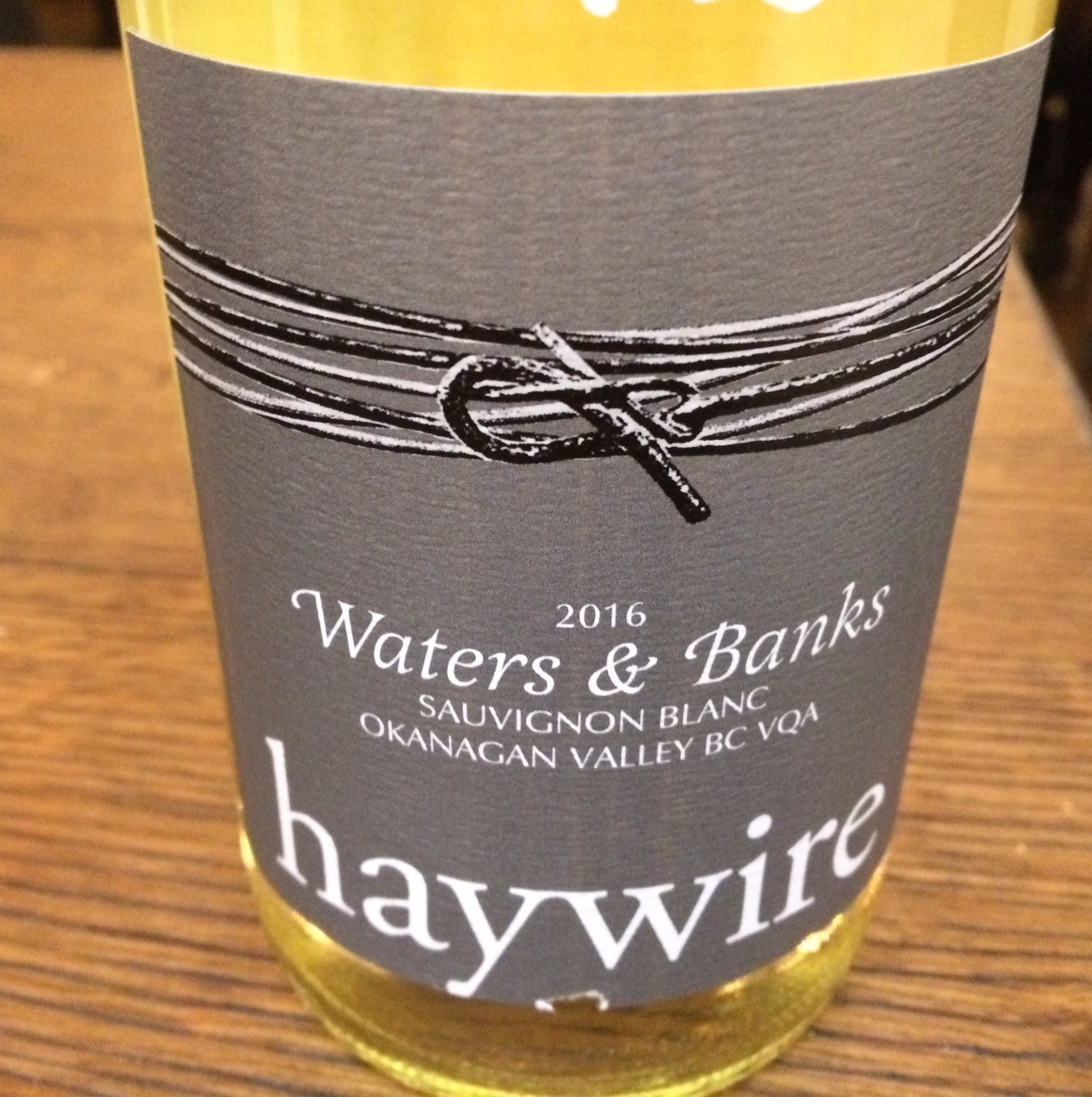
2016 Sauvignon Blanc, Haywire Waters & Banks,
Okanagan Crush Pad Winery
Okanagan Crush Pad Winery
Christine Coletta, one of the people involved in the Okanagan Crush Pad Winery, organised our itinerary in British Columbia back in 1996. Their Sauvignon Blanc has grassy aromas and is richly textured, complex and with good length. Trade price £16, distributed by Graft.
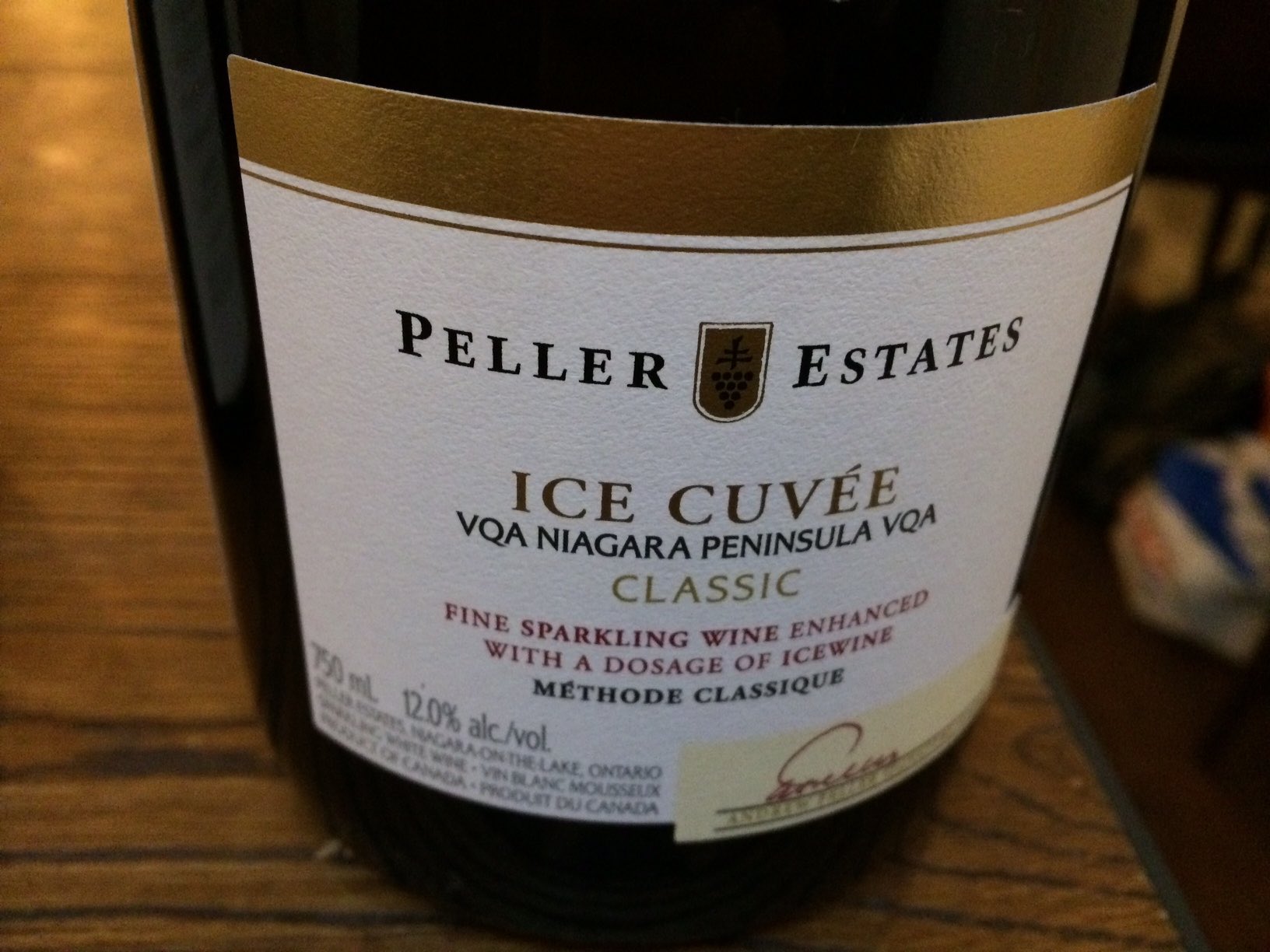
Ice Cuvée Classic, Peller Estates, Niagara
This sparkling wine from the Peller Estates has an interesting twist as its dosage is ice wine, which is very much a Canadian speciality. The addition of the ice wine naturally gives this sparkling wine both some sweetness and a round texture with a touch of honey. A crowd pleaser, though I suspect that to my taste I would enjoy the first glass but quite probably find that subsequent glasses cloying. Trade price: £21.56, distributed by Enotria.

2018 Baco Noir, Niagara, Henry of Pelham
It is always interesting to taste a grape variety that you encounter only rarely. In this instance, Baco Noir, a hybrid that is popular in the US North East and Canada but rarely encountered in France nowadays. Dark, densely coloured the 2018 has mouth-filling, slightly rustic fruit with leafy aromas and good freshness in the finish. Probably best drunk young to enjoy its dark fruit, Trade price: £9.04, distributed by Wine Rascals.

2015 Syrah, Painted Rock, Okanagan
This powerful dark and dense Syrah from the Painted Rock winery in the Okanagan Valley was for me the best of the Canadian reds that have distribution in the UK. It has concentrated and powerful black fruits and length. Still youthful it would benefit from more time in bottle.
There were several unexciting Pinot Noirs included in the tasting that I didn't think offered value for money, especially as they would hit the shelves at well in excess of £30 and, of course, even more on a restaurant wine list.
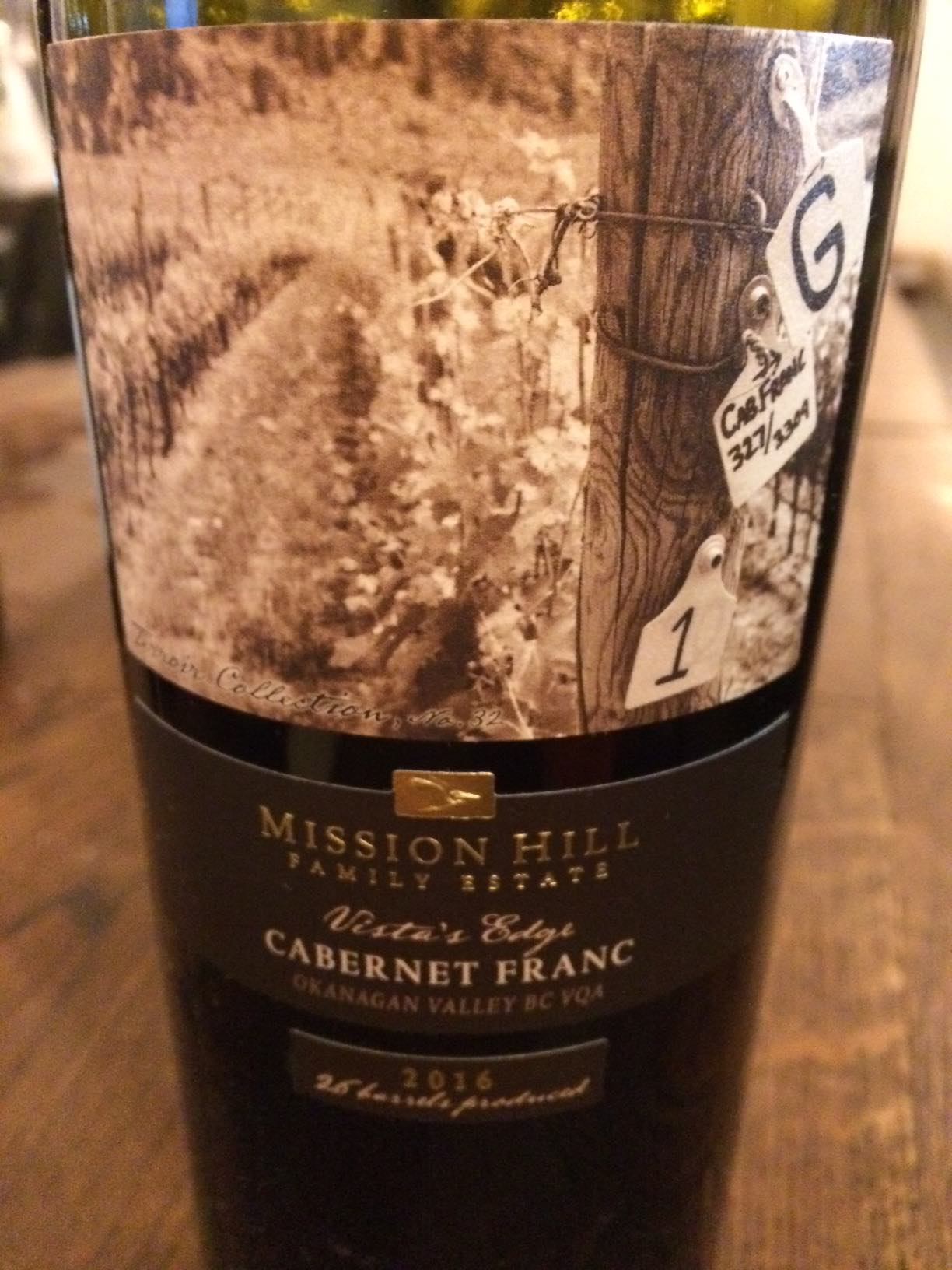
2016 Cabernet Franc, Mission Hill Family Estate, Okanagan
There were several Cabernet Francs included in this tasting, this example from Mission Hill, a long-established – 1966 – Okanagan winery was easily the most convincing with textured black fruits along with delicacy, structure and good length. I would keep this a little while longer in bottle to soften further. I found most of the other Cabernet Francs in this tasting had their fruit crushed by harsh tannins. Surprisingly for a long-established and well reputed wine estate Mission Hill is looking for a UK importer. The cellar price of this wine – $45 CAD – may provide a clue.
Ice Wines
There were also a number of ice wines to taste. I opted to taste four – all made using different grape varieties. It was a timely reminder that the concentrated acidity in these wines makes them these cloying than similarly rich sweet wines. I enjoyed all four that I tasted – Vidal (Henry of Pelham) trade price £11.43 (200 mls),Wine Rascals. Cabernet Franc (Inniskillin) £50.70 trade (375 mls) Liberty. 2017 Riesling (Peller Estates) trade £33.96 (375 ml) Enotria. Finally the most interesting, complex and unlike the other three from the Okanagan Valley: a 2016 Roussanne (Rebel Pi) trade £55 (375 ml).
There were also a number of ice wines to taste. I opted to taste four – all made using different grape varieties. It was a timely reminder that the concentrated acidity in these wines makes them these cloying than similarly rich sweet wines. I enjoyed all four that I tasted – Vidal (Henry of Pelham) trade price £11.43 (200 mls),Wine Rascals. Cabernet Franc (Inniskillin) £50.70 trade (375 mls) Liberty. 2017 Riesling (Peller Estates) trade £33.96 (375 ml) Enotria. Finally the most interesting, complex and unlike the other three from the Okanagan Valley: a 2016 Roussanne (Rebel Pi) trade £55 (375 ml).
Bachelder, Henry of Pelham, Inniskillin, Le Vieux Pin, Norman Hardie, Okanagan Crush Pad, Painted Rock, Pelee Island Winery, Peller Estates, Quails’ Gate Winery, Stratus, and Westcott Vineyards.
Friday, 1 November 2019
Loire 2019 – a final report: Anjou and Chinon + Le Pot de Lapin (Saumur)

Part of the hamlet of Chaume showing some of the vineyards
of the Quarts de Chaume Grand Cru
of the Quarts de Chaume Grand Cru

Quarts de Chaume (15.10.19) – bunch of variable ripeness

A bunch that appears to have been frazzled by the sun

Mushrooms in the Quarts de Chaume (15.10.19) reflecting
the end of the drought from 21st September
the end of the drought from 21st September
followed by a spell of we weather
Anjou
On Tuesday 15th October we headed across to Anjou for a quick look at how the 2019 vintage had gone here. The essential message is that the quality is good as elsewhere in the Loire but quantities are severely down due to a combination of factors starting with frost on 4th April, difficult conditions during part of flowering, drought and several summer heat spikes.
We arrived in Anjou in time to have a leisurely picnic in the Quarts de Chaume. Quite a lot of the grapes here had already been picked. Given that a significant proportion of the grapes here are now vinified dry it was impossible to tell. Furthermore it may not be easy to make good Quarts de Chaume and other Anjou sweet wines this year as the drought here broke on 21st September – figures from the Met station at Beaucouze (Angers). Overall rainfall in September 2019 was 50.5 mm mostly falling in the last 9 days of the month. For October the current total is 83 mm (up to 27th October) above the average 71.8 mm. Admittedly readings in the Quarts de Chaume do not necessarily mirror those at Beaucouze. However, mushrooms in the vineyard tells its own tale.
2019 is last year that cryo-extraction is permitted in Quarts de Chaume Grand Cru. I noted that all of Domaine des Baumard's grapes had been picked. It will be interesting to see whether the strategy of Domaine des Baumard changes with cryo-extraction ruled out. Will they, perhaps, follow other domaines who are increasingly making dry Chenin here? It might also be worth keeping an eye on ebay or Gumtree for a cryoextraction facility going cheap .........
Comments from Anjou producers (15th October 2019):
Réné Papin, Château Pierre-Bise, Beaulieu-sur-Layon
"We started on 23rd September picking for our Crémant. We have now finished the dry whites. Quality is good but quantities are catastrophic due to frost on 4th and 25th April as well as the drought and the summer heat spikes. We started the reds at the end of September and finished last week. The grapes that remain are nicely mature but volume is well down. Yesterday we did a first sweep through the vines for the sweet wines – recording a potential of 21.3 degrees in Les Rouannières, which was pleasing but there will be less sweet wine this year.
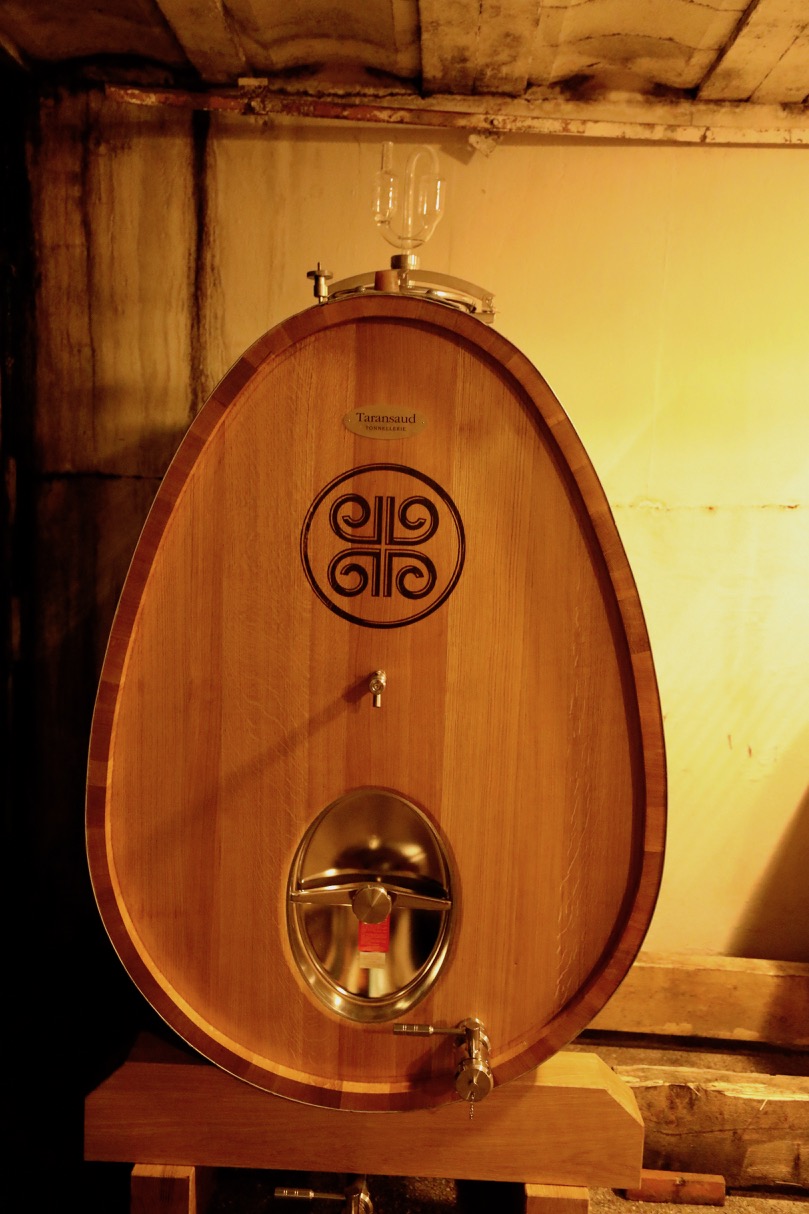
Smart new Taransaud vat – Adrien's new toy!
Adrien Moreau, Domaine Belargus, Saint-Lambert-du-Lattay
"We have finished. There will be just dry whites this year no sweet wines. We picked Les Treilles (the famous steep vineyard on the north side of the Layon that overlooks the river) in two tris in mid-September."
As well as trying some of the promising fermenting 2019s I also tried a few of the 2018s that had just been bottled – again they showed their potential with Les Gaudrets, Savennières showing particularly well. Les Gaudrets is a small parcel above the village of Savennières in the eastern part of the appellation. The 2018 Ronceray dry Chenin from Quarts de Chaume I found less expressive at present with a tight finish – just needs some time.
Emmanuel Ogereau, Domaine Ogereau, Saint-Lambert-du-Lattay
Again a similar message: "Quality – yes; quantity – no. We started on 13th September in Savennières, on the parcellaires on 16th September and finished the harvest on Friday 5th October. We haven't made any sweet wine this year and no Côte de la Houssaye (Cabernet Sauvignon) which was badly hit by frost on 6th May. Yields are low, especially for the whites – our Chenin is at 15 hl/ha. The reds are better 30/35 hl/ha, so overall we are at around 20 hl/ha."
Marie Guégniard , Domaine de la Bergerie, Champ sur Layon
"We have finished – having started on Monday 16th September and finished on 7th October. The quality is good but volume is small – 20 hl/ha. We have made any sweet wine this year instead making more dry white. For the whites the potential alcohol degrees are quite high but have good acidity – more than last year. The reds are less structured than the 2018s.
Eddy Oosterlinck, Domaine de Juchepie, Faye-d'Anjou
"We started on 22nd September with the sec with potential degrees up to 14.5% but some lower between 13-13.5%. We have started our selective picking for the sweet wines. Saturday's grapes were between 18.5%-19% and yesterday (14.10.19) was up to 20%. However, we are now waiting a week as it has rained quite a bit. Quantities are down by 20%, so a yield of around 16 hl/ha."
As with the other producers Eddy was happy with the quality.
Chinon
The following day we dropped in on a couple of Chinon producers – Jérôme Billard (Domaine de la Noblaie) and Francis Jourdan and Philippe Pichard (Domaine Jourdan).
Jérôme Billard
"We started picking our Chenin on 23rd September finishing on 26th. Potential alcohols are between 12.75 and 13.7 with acidity varying between 5.15 and 6.45 – good acidity levels. Our yields are around 43 hl/ha. We picked grapes for our Rosé on 27th September. For our reds some of our Cabernet Franc benefitted from the start of the rains making the skins softer and less thick. Yields for our grands terroirs are around 23-26 hl/ha. Elsewhere they are up to 45 hl/ha - 55 hl/ha.
Our yields were affected by the cold and wet conditions at the beginning of June that caused some of our fruit not to set properly. Maximum temperatures in early June were only 14˚C but from the 15th they were at least 25˚C."
The end of June saw a sharp heat spike with temperatures hitting around 40˚C.
Philippe Pichard and Francis Jourdan
Philippe: "We started picking on 30th September and finished on 9th. Our yields are correct – between 40 and 45 hl/ha. The wines are deep coloured. We were affected by the drought but our grapes weren't frazzled by the sun. The grapes were small but with a surprising amount of juice."
Francis (president of the Chinon Appellation): "The harvest has gone well despite volume being down by 50% due to the frost (25%) and 25% because of the drought. Savigny en Véron was particularly affected by the drought. Here is the soils are very sandy and do not retain water. Overall yield vary from 20 hl/ha to 45 hl/ha."
We also dropped into Baudry-Dutour but both Christophe Baudry and Jean-Martin Dutour were absent.
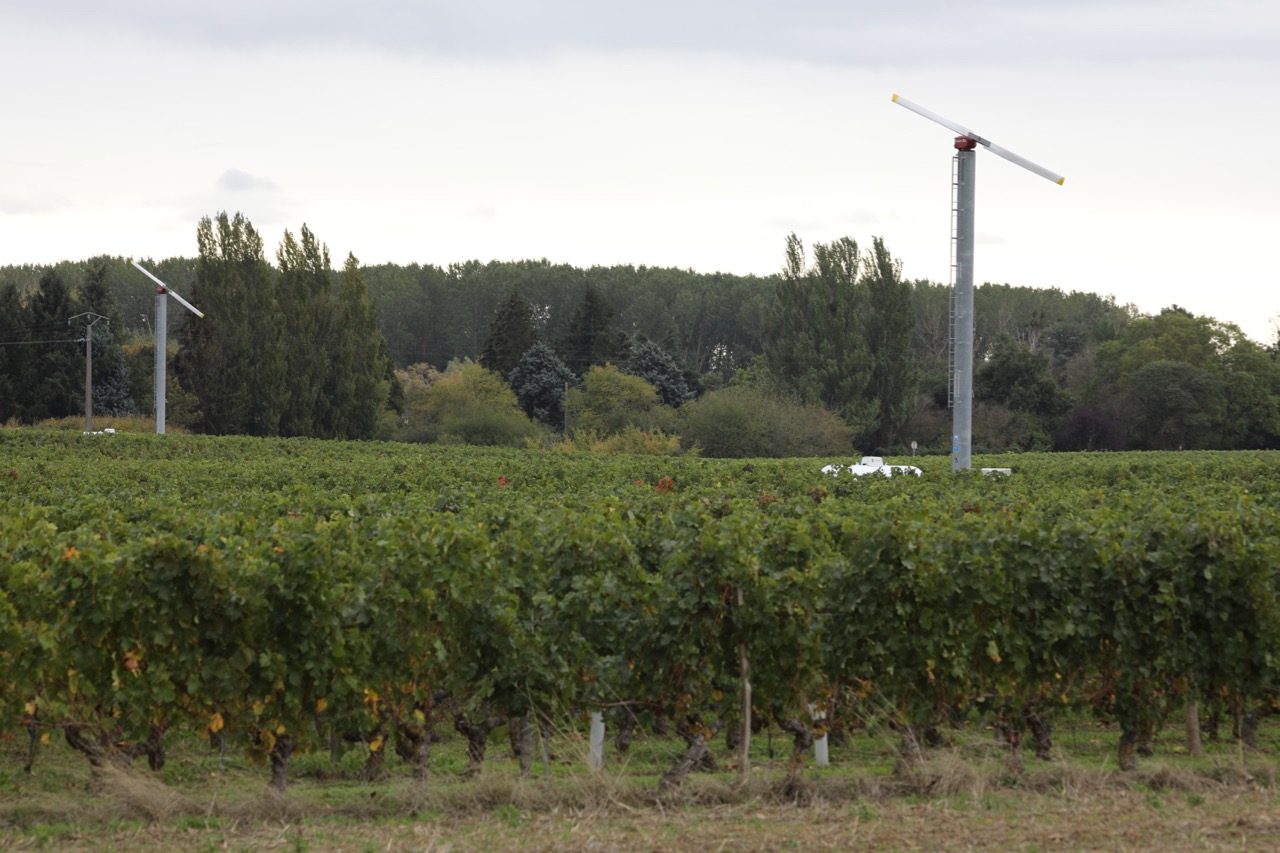
Frost protection machines in the commune
of Panzoult (Appellation Chinon)
(above and below)
of Panzoult (Appellation Chinon)
(above and below)
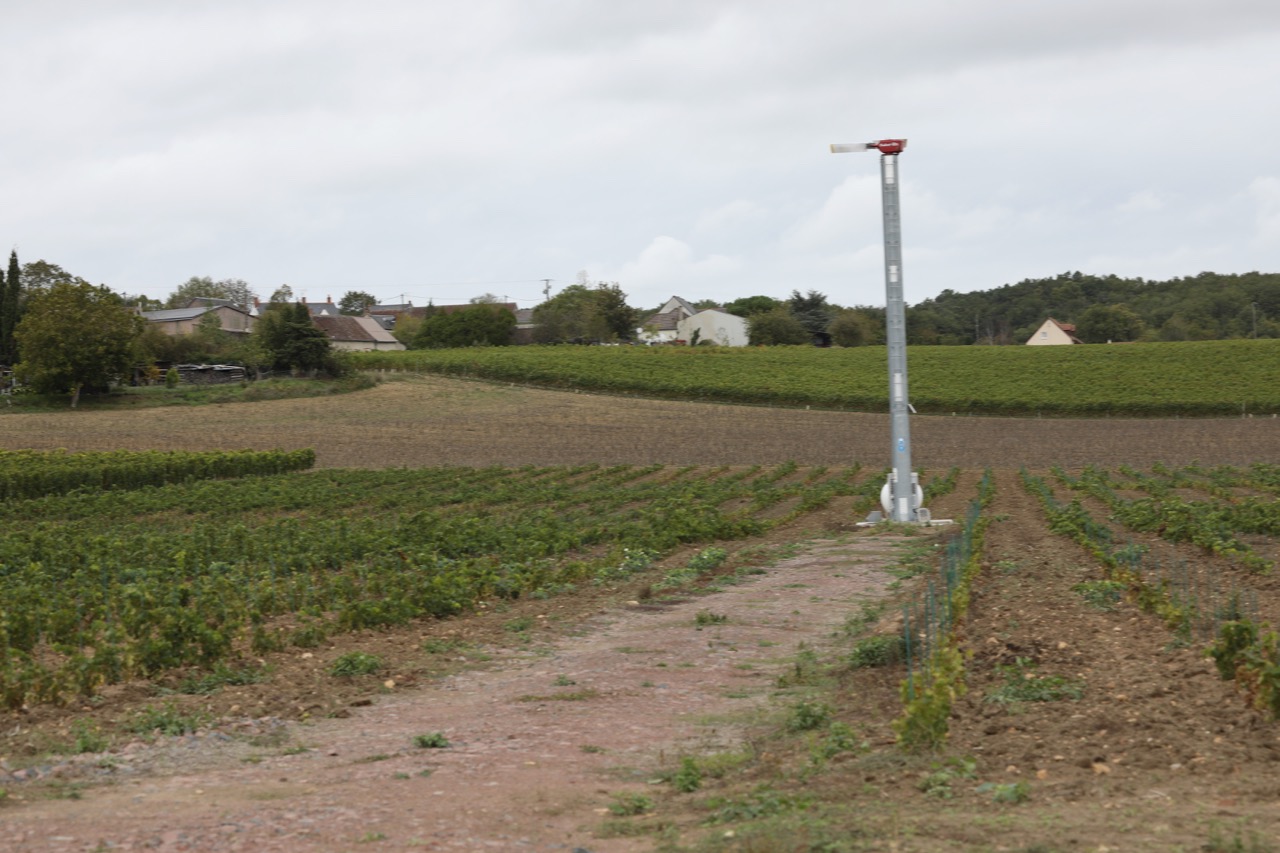
•••
Le Pot de Lapin (Saumur)
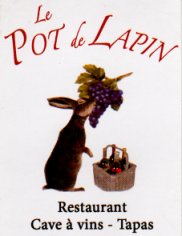
We have long been fans of Le Pot de Lapin. If I remember rightly we first went there in 2005 soon after it opened finding the relaxed style of eating very enjoyable along with a very good wine list with Saumur and Saumur-Champigny producers having pride of place. Naturally when we hear earlier on this year that Olivier Thibault had sold up we were concerned that a favourite Loire eatery would now disappear. Fortunately this is not the case as Le Pot continues under new owners.
Following our speedy visit to part of Anjou we stayed overnight at the refurbished Cristal Hotel that is on Saumur's Quai de Loire overlooking the river and named after Antoine Cristal. Naturally we decided to try out Le Pot de Lapin. The new owners formerly ran a restaurant down in Provence but decided that the heat of the summer was too much and have sought refuge in the Loire. He rattles the pots and pans in the kitchen to great effect, while Madame runs the front of house. Happily the wine list continues to feature the local growers. We enjoyed a bottle of Dominique Joseph's 2015 Les Poyeux, Saumur-Champigny. We decided that although under Olivier the cooking had always been good, it has now moved up a notch.
We can certainly recommend Le Pot de Lapin under its new ownership. The restaurant is small, so always best to book. The refurbished and centrally located Cristal Hotel is also recommended as being comfortable and reasonably priced.
Le Pot de Lapin
49400 Saumur
Tel: 02.41.67.12.86
Thursday, 17 October 2019
2019 Loire: Sancerre, Pouilly-Fumé and Vouvray

Sancerre in the evening light – taken from above Chavignol
Quick summary of reports: good to excellent vintage in Sancerre, Pouilly-Fumé and Vouvray
In the middle of last week we spent a day and half making a number of quick visits in Sancerre and Pouilly-sur-Loire to see how the 2019 vintage had gone. Unfortunately it hadn't been possible for us to get there during the harvest. Although we did spot one small team still picking, everyone else had finished.
Sancerre
François Crochet, Bué"We have to keep our feet on the ground. Yes we do have some very good vignerons and exceptional terroir but we have had a lot of luck to have another exceptional vintage!"
This is certainly true as Sancerre has largely avoided the various frosts that have hit other parts of the Loire hard over the past few years, including neighbouring Pouilly-Fumé that has suffered.
"We started on 18th September and finished on 28th. Pinot Noir ranges from 13%-14.8% and the Sauvignon from 12.8% and 14.2% with the ph around 3.25."
Tasting a number of fermenting vats with François it was easy to see why he is pleased with 2019 as was in the case with those that I tasted with Matthieu Delaporte, Clément Pinard.

Tasting the fermenting 2019 Sancerre Blanc in Matthieu Delaporte's
grandfather's cellar in Chavignol
grandfather's cellar in Chavignol
Matthieu Delaporte, Domaine Vincent Delaporte, Chavignol
"We started on the 16th September and finished on Tuesday 1st October. I am particularly happy with the grapes that we picked in the first week before there was any rain. The grapes were very well balanced. After we had some rain from around 22nd September the acidity levels dropped a little. We picked for the Rosé on 21st and then the reds on 23rd and 24th. Potential alcohol for the whiles is around 13.5%, while for the reds it is between 13.3% and 13.5%. Compared to last year quantity is down by between 10%-15%"
Jean-Laurent Vacheron, Domaine Vacheron, Sancerre
"Despite two years of drought we have a normal vintage in white, although the quantity of red is down. We had no rain from early June to September. We started on 12th September and finished on 4th October. We started the Pinot Noir on 24th September. The harvest took a little longer than we anticipated as we lacked pickers. 140 pickers signed up to harvest for us but on 80 turned up – 43% less than expected. The peaks of sunshine did burn some of the grapes and there was some oidium near the Loire."
Benoît Fouassier, Domaine Fouassier, Sancerre
Like the other vignerons Benoît is very happy with his 2019.
"Vineyards where the soil is harrowed suffered less from the drought than those where the soil isn't turned over. We started on 16th September and finished on 30th. The Pinot Noir grapes were perfect (Benoît showed me a video on his phone of perfect bunches moving along the sorting table.) Our Sauvignon Blanc ranges from 13%-14% potential with acidity between 4 and 4.5 and a yield of between 50-55 hl/ha. 2019 is fresher than 2018 as it was less hot for most of the vendange. The reds have a little less concentration than last year but more fruit flavours."
Clément and Vincent Pinard, Domaine Vincent Pinard, Bué
Vincent: "Despite the incidence of coulure caused by wet and cold weather during the flowering we are reasonably content. We started on 16th September and finished last week on 2nd October."
Clément: "2019 has a great potential. The drought and the heat spikes concentrated both the sugars and acidity in the grapes. Our Sauvignon Blanc came in between 12.5% - 13.7% potential with the acidity varying between 4.20 and 5.10 and Pinot Noir between 13.5% and 13.7% with 4.3 acidity. Overall quantity is down on last year".
Pouilly-Fumé
Loic Cailbourdin, Domaine Alain Cailbourdin, Maltaverne"Quality is good and are average yield is 42 hl/ha due to the drought and grapes being frazzled by the sun. Our Sauvignon came in around 13% or more with acidity between 4.4 and 4.5 and a ph of 3.26-3.30, which is a good balance. The acidities are similar to last year. The Ban des Vendanges was on 16th September but we started on the 20th September and finished on Thursday 3rd October."
Sébastien Redde, Domaine Michel Redde, Saint-Andelain
"It's a good harvest with a yield of around 45 hl/ha. The berries were small and we had a frost at the end of April. Regarding other vintages 2019 reminds me of 1997 and 2015. Our Sauvignon was at 14% potential, acidity at 4.5 and ph between 3.25 and 3.30".

Looking towards the steep slopes of the Cul de Beaujeu, Chavignol
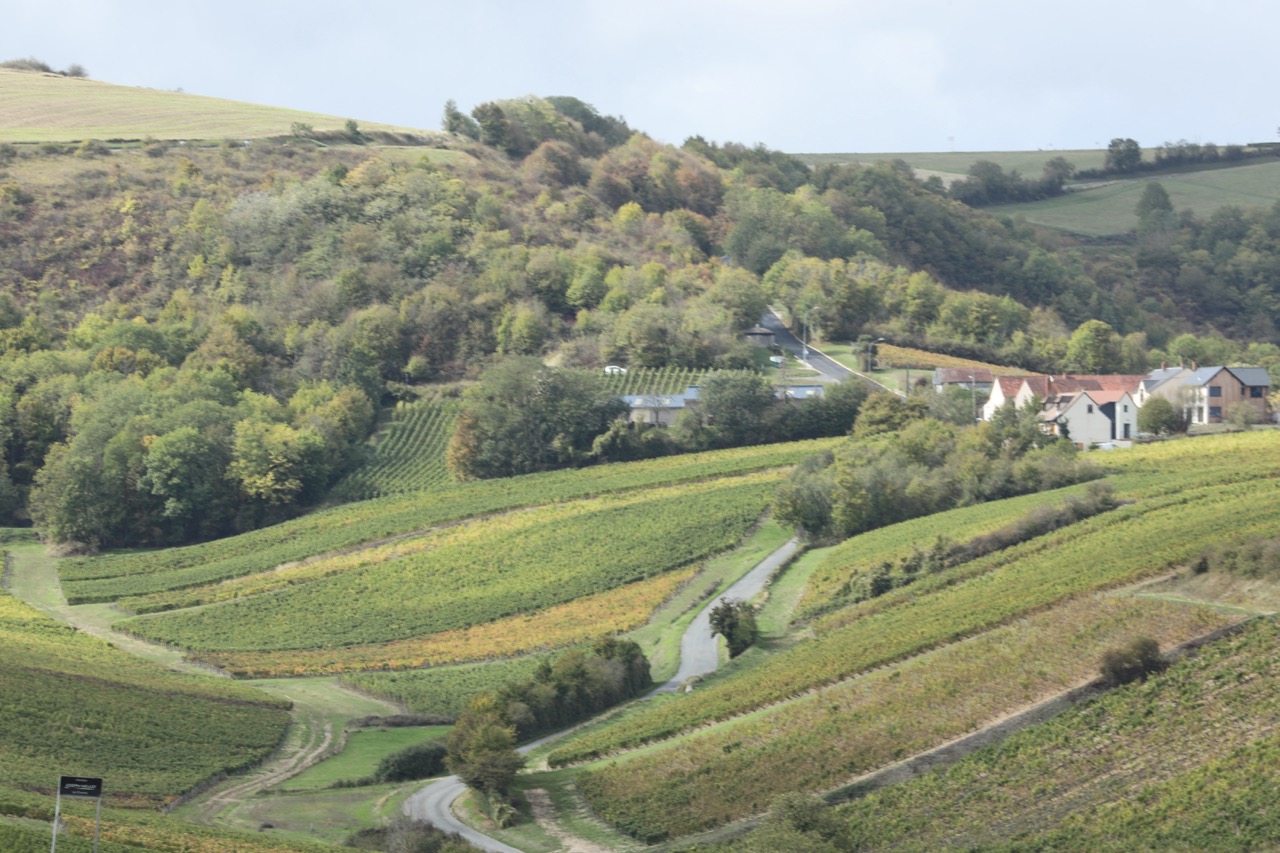
Towards the little village of Amigny
– part of the Commune of Sancerre
– part of the Commune of Sancerre

Looking down on the little village of Chavignol
home of many leading Sancerre producers
home of many leading Sancerre producers
•••
VouvrayOn Friday afternoon (11th October) I rode over to Vouvray crossing the Loire at Amboise and returning by the Charles de Gaulle Bridge between Vouvray and Montlouis – an excursion of 90 kms on an e-bike. There were a good number of other cyclists about trying out the end of route of the Paris-Tours race, which was run on Sunday.
Julien Pinon, Domaine François Pinon, Vernou-sur-Brenne
I arrived the day after they had finished picking, so they were in the middle of their Berlot – the traditional party for the pickers to celebrate the end of the harvest. I managed to prise Julien away from the festivities for a few minutes to chat about the 2019 harvest.
"We started on 16th September picking our base wines for our sparkling and finished yesterday (10th October). We have a very high quality in 2019. Potential alcohols vary between 11.5% for our pétillants and 13.7% for the demi-sec. We have made any moelleux this year as the degrees didn't go high enough, the rains have started and we made a lot last year. Unfortunately it is very difficult to sell sweet wine at the moment. We had five nights of frost from 4th April to 6th May leading to 30% loss. Then the drought and between 10%-20% loss due to grapes being burnt by the sun not forgetting coulure and millerandage. Thankfully with the early frost on 4th April the second generation grapes came through and ripened. Also to our surprise there was a lot of juice in the berries".
Bernard Fouquet, Domaine des Aubuisières, Vouvray
"We started on 23rd September and finished on 8th October. Compared to last year the sugar levels are the same but there is more acidity but as there is a lot of tartaric a lot may drop out during maturation. Potential for our grapes was between 13%-14% with the majority around 13.5% with phs from 3.15 to 3.20. Still wines we have made sec and demi-sec but no moelleux this year as we made a lot last year. Overall our yields are correct – 44 hl/ha with the still wines at 35 hl/ha. We lost 10% to frost as well as some to the drought and the heat spikes. Where we have rows running north- south we had losses due to the strength of the afternoon sun. I have a friend who told me that with the ozone level shrinking the sun's rays are now more aggressive."
Bernard was not to be drawn whether he preferred 2019 to 2018. "It's too early to say...."
Tuesday, 8 October 2019
Some senior moments @Epeigné-les-Bois
All ready for their lunch
Epeigné-les-Bois' annual Répas des Aînes was held on Saturday 5th October starting at noon and finishing a little after 4pm. It was the last time Christian Percevault, the current Maire, will address les invitées as he will be stepping down when his term finishes next year. The Conseil Municipal always serve the invitées.
The first course all plated up and ready to go
L'equipe – above and below
Christian announcing that he will not be seeking another term in 2020
Loire 2019 – Saumur, Saint-Nicolas-de-Bourgueil and Bourgueil

Picking @Domaine de la Butte, Bourgueil
Some photos and reports from harvest in Saumur, Saint-Nicolas-de-Bourgueil and Bourgueil on 3rd October.

2019 Cabernet Franc in vineyard along Montée de l'Angle Cher, Saumur
Above and below
(Saumur-Chempigny)
Above and below
(Saumur-Chempigny)
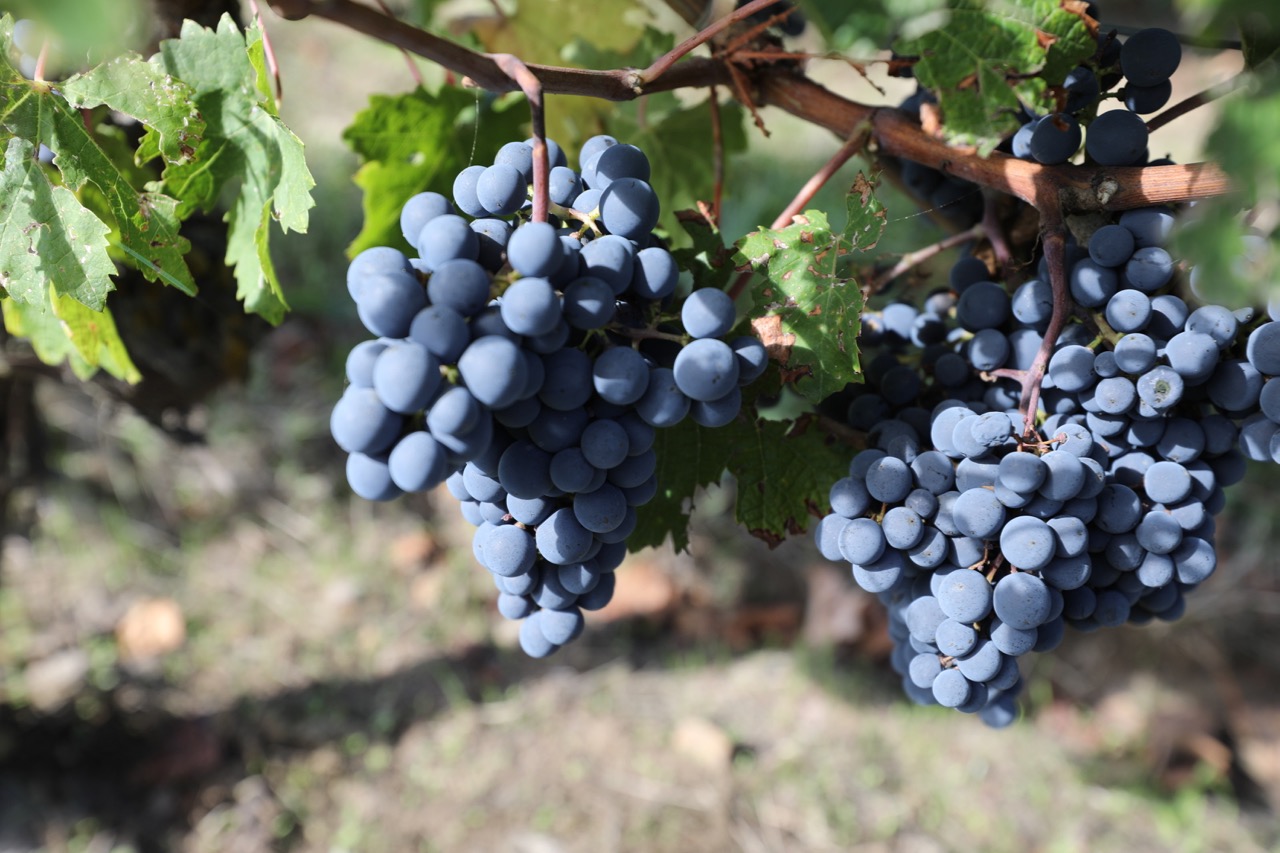
Picture perfect Cabernet Franc
We made a number of visits on Thursday 3rd October to vignerons to see how the 2019 harvest was progressing. The overall message is that 2019 is another quality vintage, that it is a very good vintage for whites with a better balance and freshness than 2018. However, unlike the generous 2018 vintage, 2019 is a small vintage due to a combination of factors – spring frosts, coulure and millerandage during flowering due to wet conditions in early June, drought and grapes being grilled by the sun.
In last week's post I raised the frequency of grapes being frazzled by the heat spikes at the end of June and during July. It would appear that the spike at the end of July caused the most damage. It also seems that Chenin Blanc was more affected by the heat of the sun than Cabernet Franc. Raising the height of the canopy is one way of providing more protection through increasing the amount of shade compared to vines with a low canopy.
As is often the case there were some who were only just starting – Anthony and Cedric Bonneau (Domaine de la Bonnelière – Saumur and Saumur-Champigny. They had started that day on picking Cabernet for their rosé and would also be picking their Chenin Blanc for their Saumur Blanc. They had picked grapes destined for their Crémant de Loire between the 22nd and 24th September. However, they would only start picking their Cabernet Franc for Saumur Rouge and Saumur Champigny at the beginning of this week beginning 7th October. In contrast Antoine Sanzay, Jean-Pierre Chevallier (Ch de Villeneuve), Frédéric Mabileau, Yannick Amirault and Philippe Boucard (Lamé Delisle Boucard) were all close to finishing.
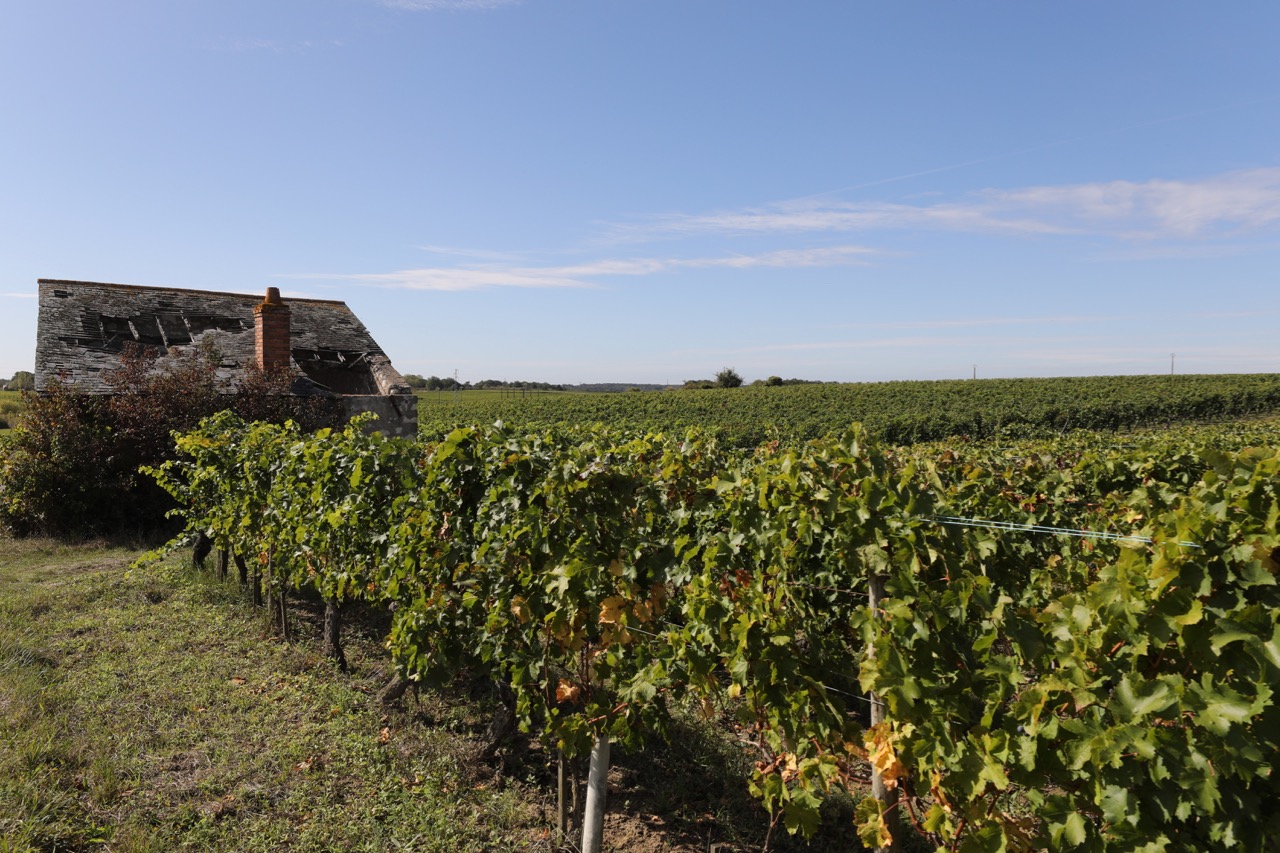
Higher trained vines not only provide more foliage
but also increased shade give further protection against sunburnt grapes

Example of higher foliage providing more shade
+ vine suffering from Esca
+ vine suffering from Esca

Chenin Blanc grapes grilled by the sun, Saumur
Picking @Domaine de la Butte, Bourgueil

Frédéric Mabileau– 2019 Cabernet Franc
again picture perfect fruit
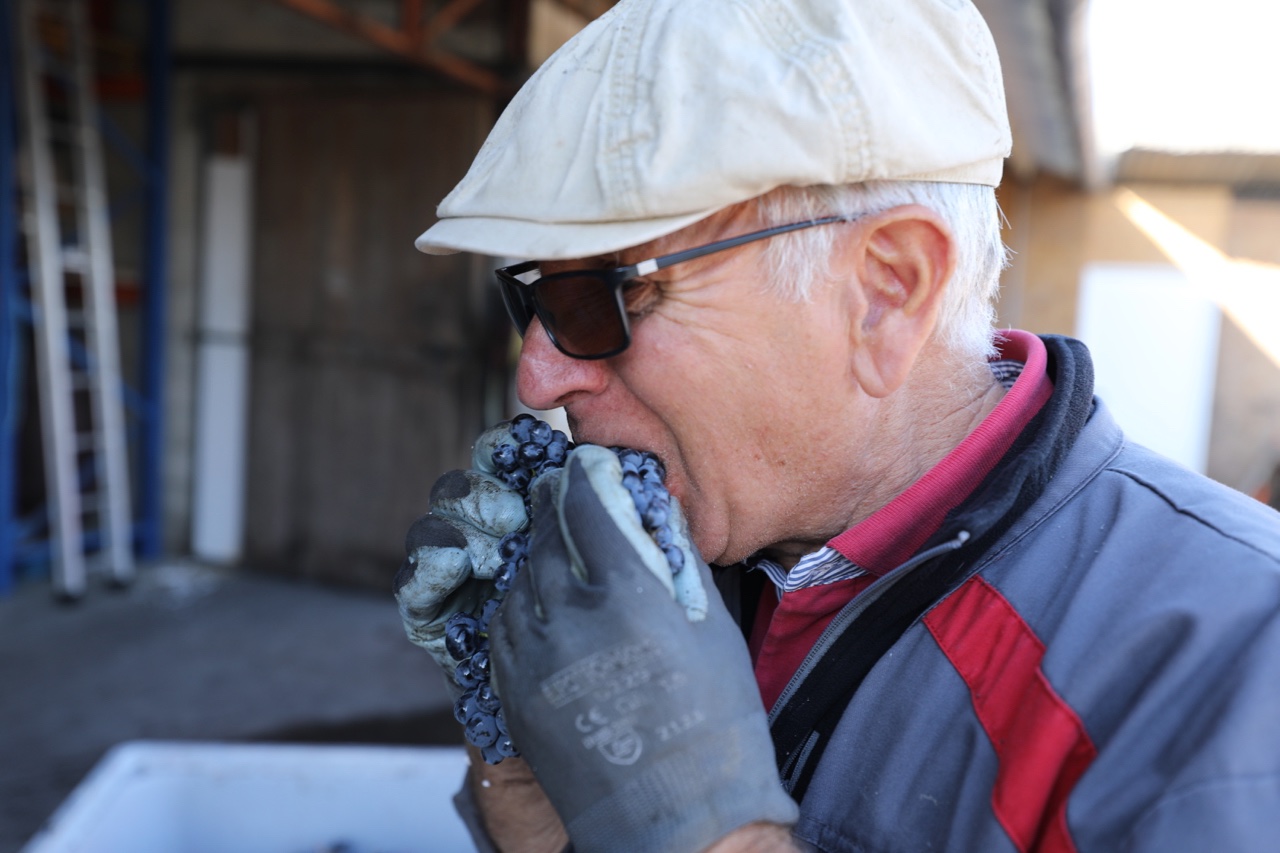
Jean-Paul Mabileau (doesn't want to wait for the 2019 wine to be made
– he wants to enjoy the grapes now!

2019 Cabernet Franc macerating, Domaine Yannick Amirault
Bourgueil and Saint-Nicolas de Bourgueil
Bourgueil and Saint-Nicolas de Bourgueil
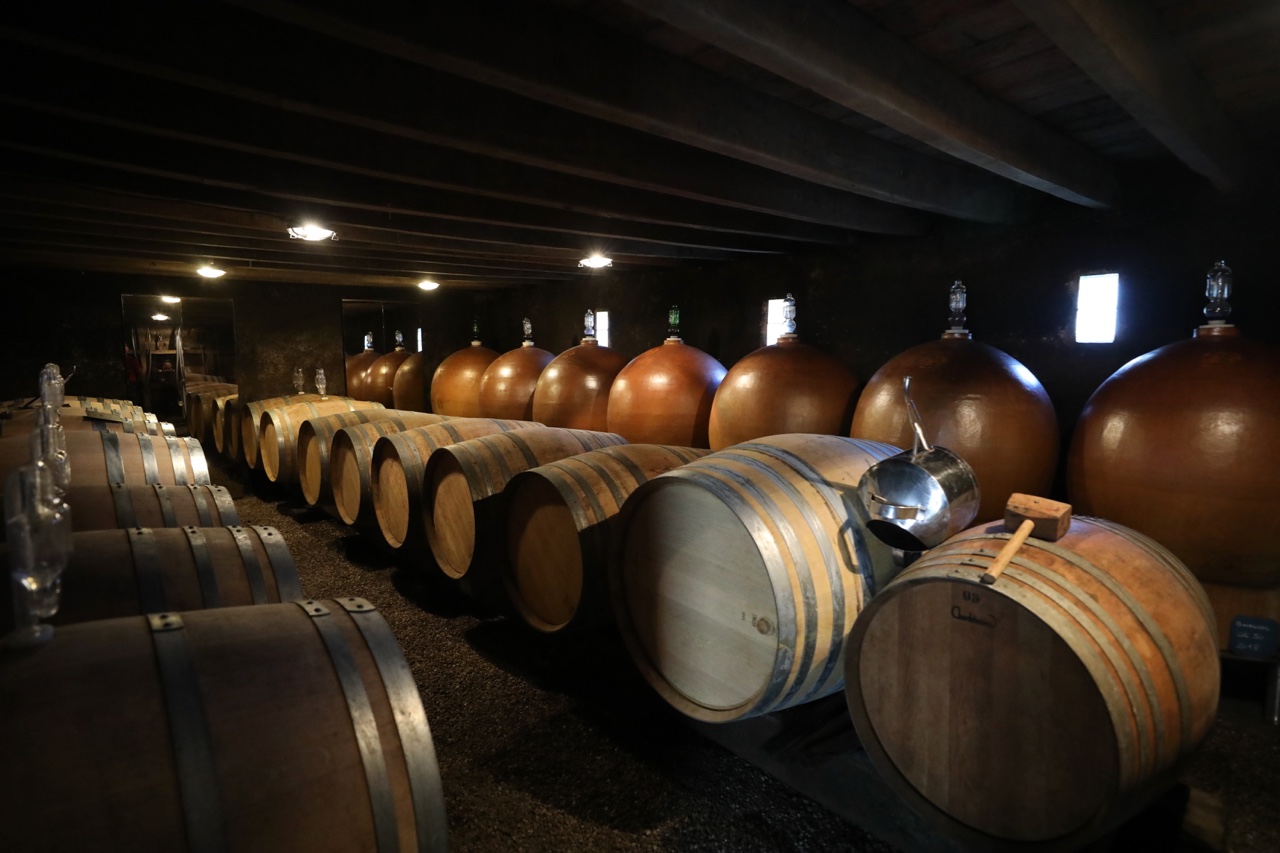
Barrels and amphores @Domaine Yannick Amirault
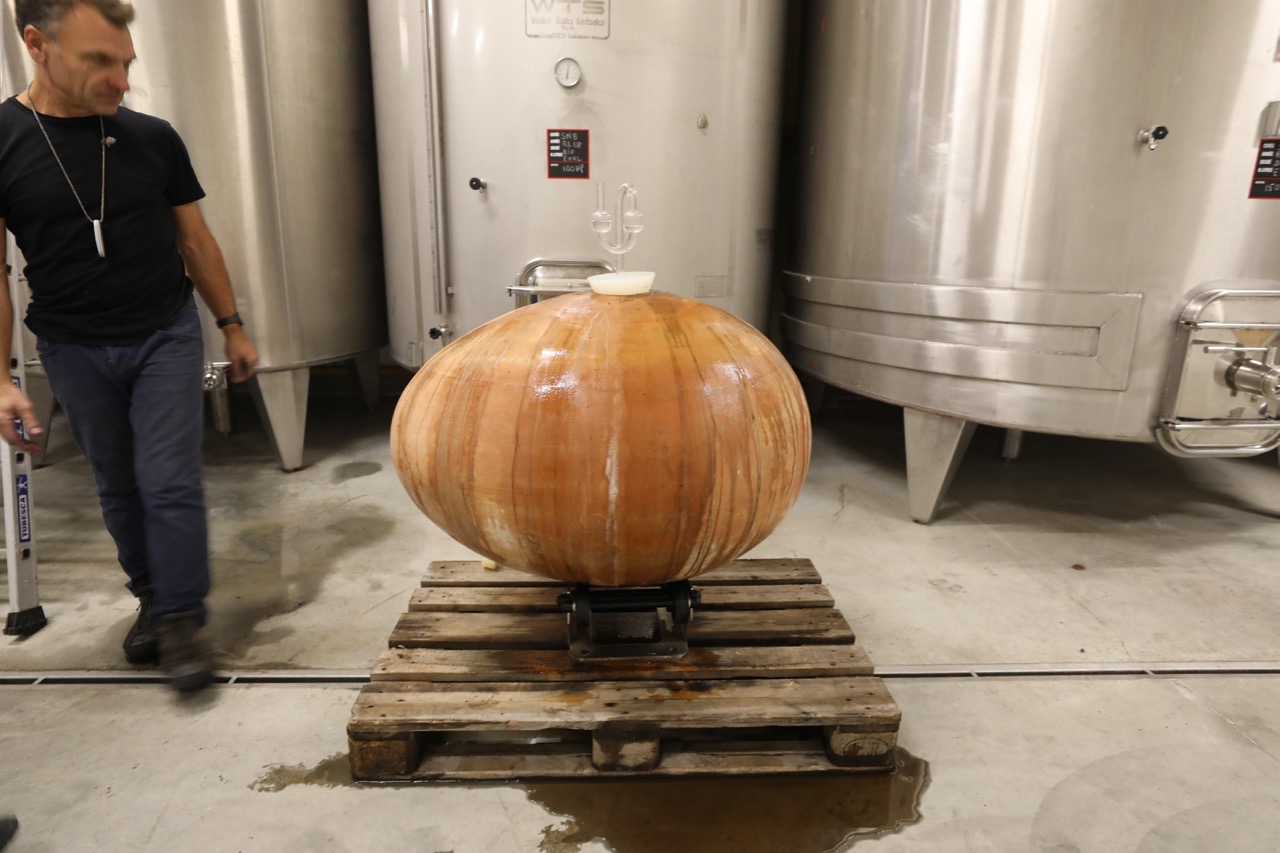
Frédéric Mabileau and his small egg
containing Chenin Blanc with pips and skins
containing Chenin Blanc with pips and skins
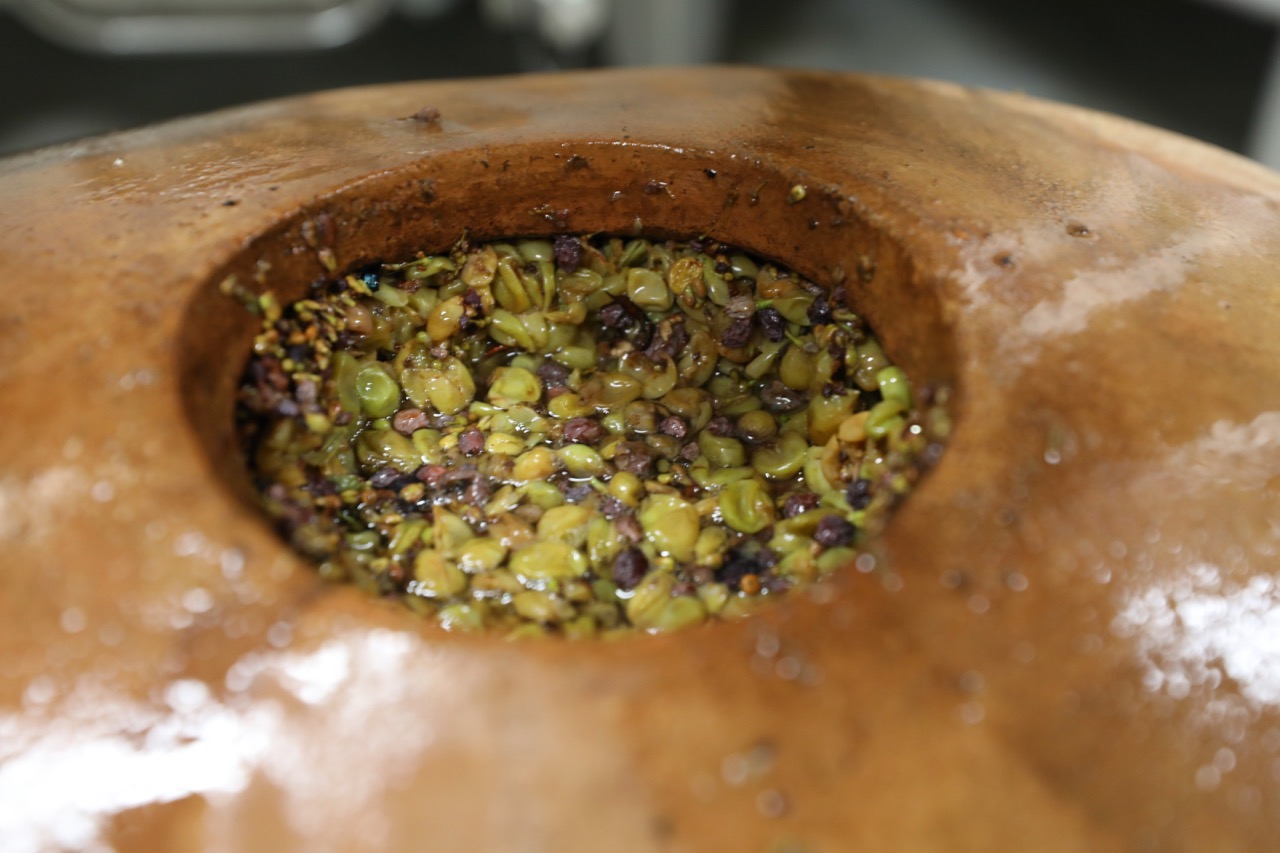
•••
Antoine Sanzay's renovated cave

The entrance to the complex of caves

During our visit to see how 2019 was progressing at Antoine Sanzay (Varrains), he quickly showed his renovated cave. The complex of cellars, part of which was once a dwelling, has for many years existed but now they have been renovated to provide wine storage space. The major work was concreting the floor to make an easy and convenient surface.

Antoine has installed a lift for easy access for his wine
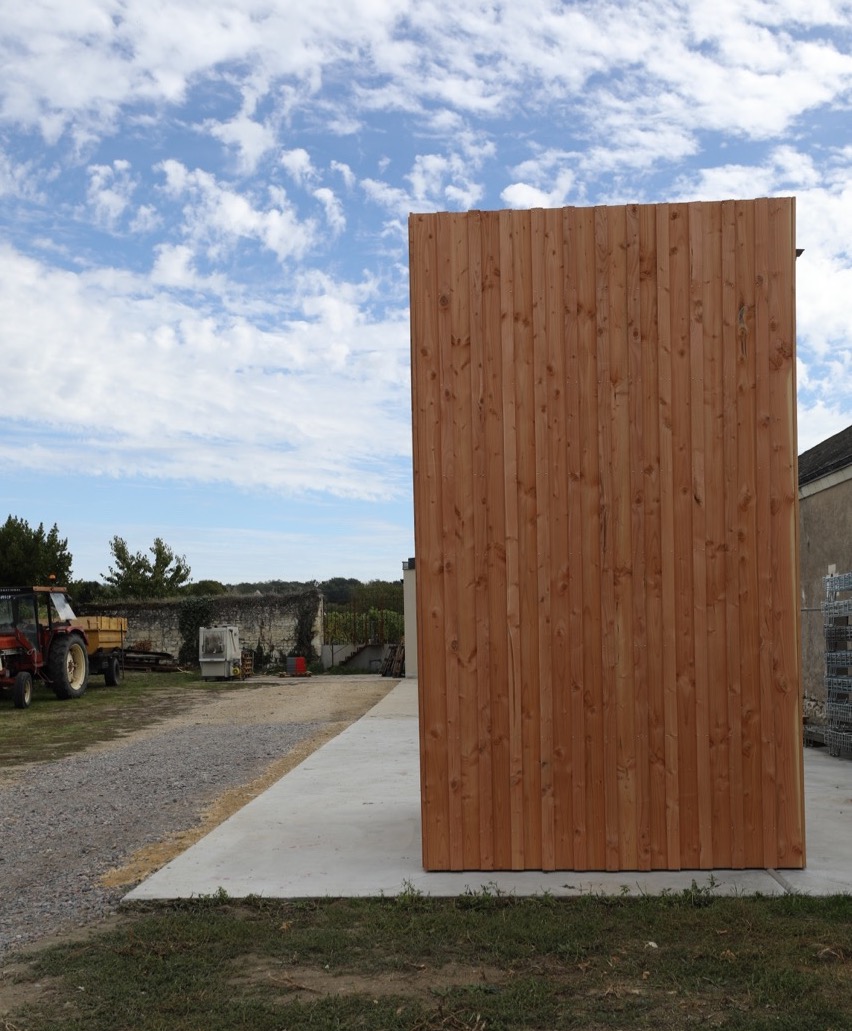
The lift housing
Wednesday, 2 October 2019
Soirée des Grands Vins de Bourgueil: le jeudi le 3 octobre (demain)
Message from Alexis Caraux, director Vins de Bourgueil
'Chers amis,
Voici LA soirée à ne pas rater cet automne !
Notez bien dans vos agendas la date du jeudi 3 octobre à la Maison des vins de Langeais.
Nous vous convions à une soirée privilège où nous allons vous faire déguster et vous proposer à la vente les plus belles bouteilles de l'appellation Bourgueil sur des millésimes exceptionnels prêts à boire (2001, 2005, 2009, 2010 et autres).
Nous vous proposerons également quelques formats magnum sortis directement de la cave des vignerons...sur ces millésimes d'anthologie !
Pour permettre aux amateurs de grands vins habitants d’autres régions d’accéder à ces cuvées rares, nous mettons en ligne quelques bouteilles à la vente 24h avant l’événement le 2 octobre.
De quoi bien préparer vos fêtes de fin d'année !
Mais attention, les quantités sont limitées... Premiers arrivés, premiers servis !
A vos marques...
Cheers,
Alexis Caraux
Directeur ODG Bourgueil'
Voici LA soirée à ne pas rater cet automne !
Notez bien dans vos agendas la date du jeudi 3 octobre à la Maison des vins de Langeais.
Nous vous convions à une soirée privilège où nous allons vous faire déguster et vous proposer à la vente les plus belles bouteilles de l'appellation Bourgueil sur des millésimes exceptionnels prêts à boire (2001, 2005, 2009, 2010 et autres).
Nous vous proposerons également quelques formats magnum sortis directement de la cave des vignerons...sur ces millésimes d'anthologie !
Nouveauté : Vente éphémère le 2 octobre sur notre boutique en ligne
Pour permettre aux amateurs de grands vins habitants d’autres régions d’accéder à ces cuvées rares, nous mettons en ligne quelques bouteilles à la vente 24h avant l’événement le 2 octobre.
De quoi bien préparer vos fêtes de fin d'année !
Mais attention, les quantités sont limitées... Premiers arrivés, premiers servis !
A vos marques...
Cheers,
Alexis Caraux
Directeur ODG Bourgueil'
2019 Loire – has heat damage become a new challenge?
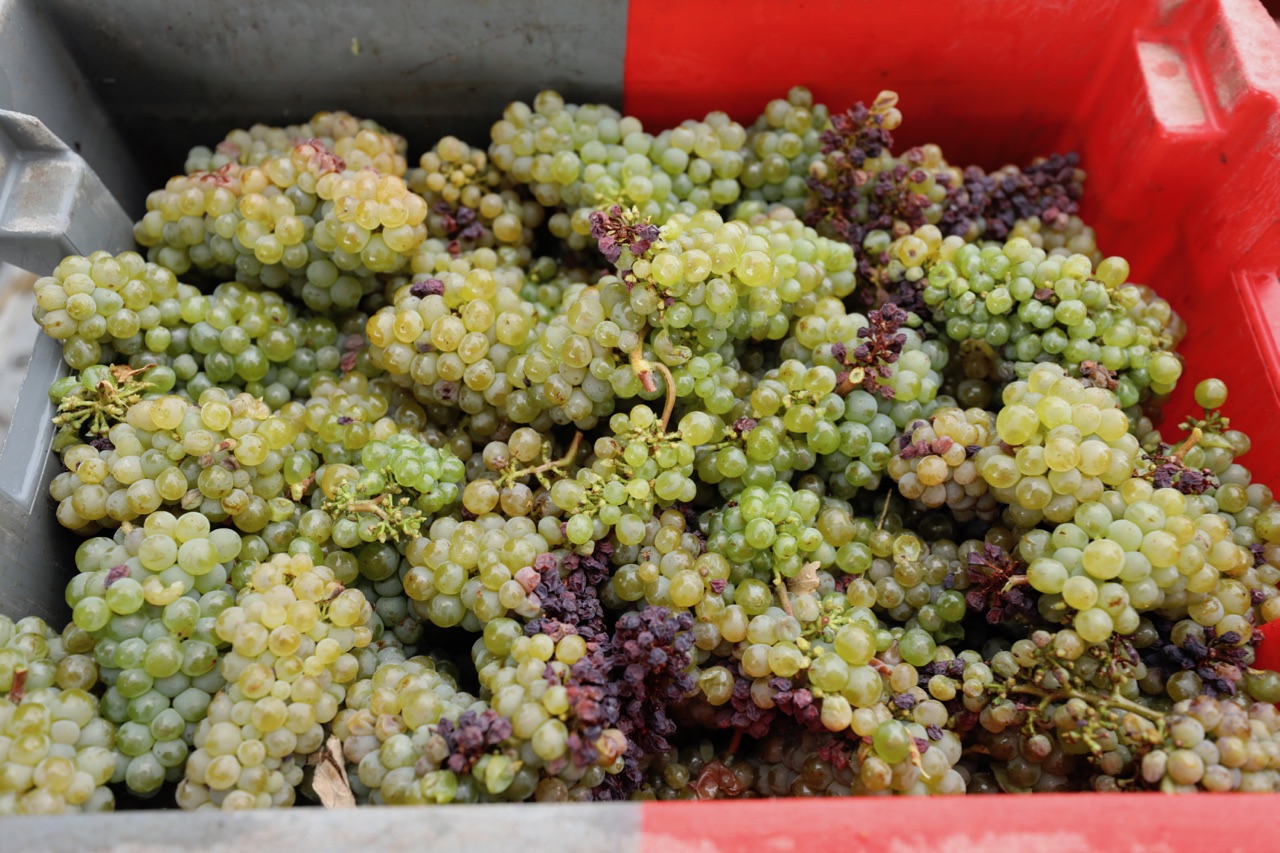
2019 Chenin Blanc from the Clos Mosny,
Domaine de la Taille aux Loups, Montlouis
Domaine de la Taille aux Loups, Montlouis

Frazzled bunch of Chenin Blanc: Clos Mosny
Jacky Blot (Domaine de la Taille aux Loups) is adamant that for whites 2018 is not a good vintage, although it is a good vintage for reds. Jacky is very pleased with the potential quality and balance of the 2019, although he was hit by both April frosts and grapes shrivelled by summer heat spikes of up to 40˚C.
However, he has been pleasantly surprised to find that his Chenin has yielded more juice than he imagined. He thought yields would be around 25 hl/ha instead they are in the region of 35 hl/ha.
But quantity is down due to April frosts, poor weather due some of the flowering period, drought and as well as grapes frazzled by successive heat spikes.

A grey 'lawn' in Cher Valley
after four months of no rain – above and below
after four months of no rain – above and below

In Eastern Touraine it was very dry from early June until 22nd September. Tours Weather Station recorded 1.2 inches of rain from 13th June to 21st September. The drought started to break on 22nd September. Everything looked very parched and when there were high winds in mid-September the emergency services were on high alert in case of fires spreading through the dry vegetation.
2019 is the sixth good quality vintage in a row starting from 2014. The Loire has never seen such a series. Previously it was exceedingly rare to have more than three successive good vintages. Looking back over this millennium only 2013 has been poor along with 2012 for sweet wines in Anjou. The days of rotten, unripe vintages in the 1960s, 70s and 80s now seems far away. Evidence, surely, of climate change.
At the International Chenin Blanc Congress at the beginning of July the South Africans said that the Loire, with its relatively small increase in temperature, would be feeling the benefits of climate change in contrast to their problems stemming from severe differences in climate. This may be so but changes are already having their effect in the Loire through increased incidences of frost plus sun frazzled grapes.
Xavier Frissant, vigneron at Mosnes and a leading actor in the push to promote Amboise to full cru status, has also been hit considerably by grapes being grilled by the sun. Incidentally 'grillé' is an expression used by the late Gaston Huet (Domaine Huet) to describe the heat of the 1947 vintage. Xavier's Chenin has been particularly hit by the sun. Grapes that face the intense afternoon sun are always the most likely to be frazzled. It was noticeable looking at some of Xavier's Côt that bunches that faced the morning sun had largely been spared, while those facing the afternoon sun had been badly hit.
"This year during the heat spikes there was a three hour danger period – from 2pm to 5pm. We may have to look again at our viticultural practices to see how we can better protect the grapes from intense sunshine."
When I first started reporting about the Loire from 1989 it was fairly common for vineyards to look like dense hedges and to have to search about for bunches. Over the past 20 years or so opening up the canopy has become common along with spreading out bunches to facilitate ripening and avoiding rot by encouraging currents of air to help dry the grapes. Deleafing has also been popular. Periods of extremely high temperatures as seen this year, even if some of the heat spikes have only lasted a few days, raises a question as to whether this is still the right approach.








